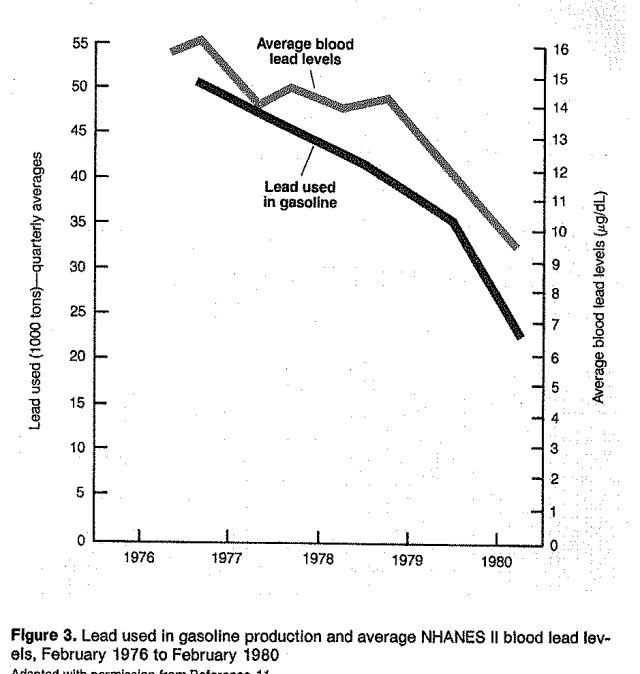The link between lead and crime has been published everywhere from science journals to Forbes to Mother Jones. Violent crime in the United States rose in the 1960s, spiked in the 90s, and has plummeted since then. Why did the generation associated with peace signs and hippies turn out to be the most violent in recent history? Many scientists point to one reason–lead in gasoline during their childhoods.
Lead in the form of tetraethyl lead was added to gasoline in the 1920s in to help electric igniting engines operate more smoothly. It worked well despite one problem with it. The additive was known to cause “madness” and hallucinations. This had been first documented in the 1850s. In fact, workers at the first lead additive manufacturing plant died after going “looney.” Despite this, the additive worked effectively and was cheap so the companies that made it pushed forward to add it to gasoline. It was temporarily banned in parts of the nation–not the Midwest however–making the breadbasket of our nation a rich source of environmental lead. With careful marketing and lobbying by the companies that made the additive, the health effects were downplayed and the new technology was given a clean bill of health by the U.S. Surgeon General in the late 1920s.Thus, leaded gasoline was heavily used across the United States for over forty years.
Analytical chemistry upped its game in the 1970s, finding that the lead persisted in the environment and in people. Many states began phasing it out in the 70s and 80s. It was banned state by state and eliminated from car gasoline in 1996. But since it is an element, lead can’t break down into anything simpler. Scientists believe that everyone over 40 in the U.S. has some degree of lead poisoning. Lead can be cleared from blood by the body but it resides in bones for 30 years or longer. Lead still lingers in many locations in the U.S.–including the poorest most violent neighborhoods. And of course, it has recently been found in water in Flint, Michigan thanks to corroding old pipes. Old paint and even old cans can also add lead to our bodies. However, lead in gasoline has been by far the most egregious contributor. As use was curtailed, lead in blood began to drop dramatically. Crime did as well.

Why is lead so nasty? Lead impairs brain growth and poisons neurons.. It lows IQ and leads to life-long mental impairment. It damages the areas of the brain that control aggression and is more toxic to boys than to girls. It contributes to ADHD. It encourages cancer. Even teen-pregnancy has been linked to lead exposure. The poorer a person is, the more likely they are to have a high blood lead level.
It’s no surprise that lead is found at high levels in shooting ranges. These are regulated by OSHA and there are rules demanding clean up but these rules are not always followed. Eating meat shot with lead is also dangerous, especially for children. Adding vinegar to game shot with lead bullets makes the lead even more soluble in the meat and increases the toxicity.
Shooting ranges are not the only source of lead in the environment. Fuel for small airplanes contains lead and they are one of the major contributors to lead pollution today.
The link between lead poisoning and crime needs to be explored more fully. The tragedy of lead poisoning in the Unites States is a sad tale of greed and lack of regulation. Every one of us has suffered to some extent from exposure to lead. The cautionary take-away is that when it comes to chemicals, we need more regulations and more care taken before approving them for use in consumer products.


Fascinating and frightening. I especially appreciate your reference to lead being an element. When I don’t deal with those “kernels” day to day, it’s easy to forget, but now I remember.:-)
Your post made me think of the Franklin Expedition – the possibility that some crew died of lead poisoning. However, I see that more recent research tends to discount that possibility in favor of zinc deficiency http://www.nature.com/news/fingernail-absolves-lead-poisoning-in-death-of-arctic-explorer-1.21128 and exposure to the elements https://www.theguardian.com/science/2014/jan/26/lead-poisoning-polar-sir-john-franklin
When my dad was stationed in Germany in the early 1980’s, a small number of German gas stations had unleaded fuel at the time; the catalytic converter on his American car had to be removed to avoid damage to it from the leaded gasoline.
Thanks!
LikeLiked by 1 person
Very interesting. And now the question, why such a lack of zinc?
LikeLiked by 1 person
Excellent question. Since John Hartnell’s body was the only one a fingernail was recovered from, researchers weren’t able to determine if the other men had the same condition or not. The tests they ran showed that the men’s lead exposure didn’t spike during the expedition, only the last few weeks of their lives: “Hartnell had relatively high levels of lead only during his last few weeks, when his dying body probably broke down and released long-stored lead from his bones into his blood and nails, Christensen says.” http://www.nature.com/news/fingernail-absolves-lead-poisoning-in-death-of-arctic-explorer-1.21128#/b1 . Your article and this thread inspired me to look up more about Franklin’s lost expedition; I will definitely be reading more on the event and findings. Thanks again!
LikeLiked by 1 person
Zinc is interesting. Once I had a student do zinc tests on hair. They found that zinc levels varied with the color of hair. In fact, she compared her dog’s grey hair with that of human grey hair and the levels were similar. Sadly, I can’t remember what color hair had the most zinc but the grey hair was lower in zinc as I remember.
LikeLiked by 1 person
From the various sources I have read, it appears that the book is still open, so to speak, on the effects of lead exposure to Franklin, Crozier, and their respective crews. It was fascinating to read in “Frozen in Time: The Fate of the Franklin Expedition” how the powers that be misjudged the canned meats and vegetables to have the needed ascorbic qualities to help prevent scurvy. This article provides a summary of the lead poisoning and other theories: https://www.ncbi.nlm.nih.gov/pmc/articles/PMC1279489/ .
LikeLike
Yes, it’s true that Vitamin C has a short shelf life–a reason to rely on fresh fruits for it and not canned food or old vitamins. I think somewhere on this blog I have a post about the vitamins in frozen foods and really, they are best if consumed within six months.
LikeLike
Romans would make a syrup of grape called Sapa boiling it to a third of its volume in lead pots and used it to sweeten wine and food. This, in addition to using lead pipes for their running water and the use of lead plates or pewter plates containing high levels of lead caused some of their emperors to go mad and likely lead to the fall of Rome.
Mercury is also a factor. In the 19th century hatters, (people whose profession it is to make hats) would use mercury salts to stiffen the brim of hats. There were many acts of violence and insanity linked to hatters leading some to ending up in asylums. The expression “Mad Hatter” comes from this time. One hatter, Boston Corbett who shot John Wilkes Booth later went mad and castrated himself.
In the 1920’s there was a series of violent acts including murder/suicides all linked to people working for the same car company. The coroner found high traces of lead in their brain. The car company was working on adding lead to gasoline and the work area was improperly ventilated.
The U.S allows for the dumping of coal ash containing lead, mercury, arsenic, cadmium was allowed to be dumped in rivers and streams likely ending up in people’s drinking water. To people already exposed to leaded gasoline between 1924 and 1996 this could cause them to behave violently. Violent offenders ought to be tested for heavy metal poisoning.
LikeLiked by 1 person
Yes. People who say we have too many regulations don’t think of what we allow already!
LikeLiked by 1 person